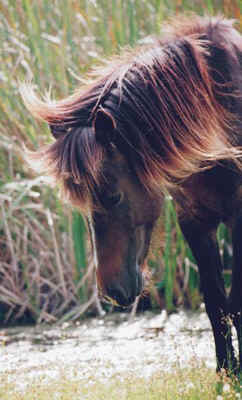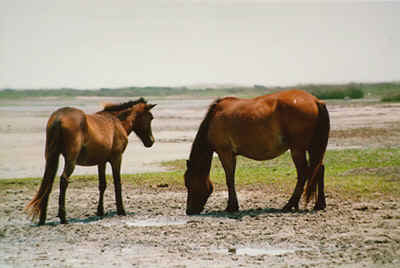|
About the Horses |
| The
Shackleford Banks wild horses are a unique historic and cultural
legacy.
Historical
research and genetics testing indicates that these wild horses
descended
from a core group of the old type of Spanish horses. One genetic
factor, the blood variant Q-ac, is believed to be contributed
by the Spanish horses of 400 years ago. This genetic marker has
been found in only descendents of those Spanish horses. Easily lost
through genetic drift, Q-ac has been documented in the Puerto
Rican Paso Finos, the isolated mustang population of Montana's Pryor
Mountains, and the horses of Shackleford Banks.
The
wild horses of Shackleford Banks are of great interest to the
scientific community as well as to the average citizen. An international
expert of equine behavior, D. I. Rubenstein, PhD, Chairman, Department
of Ecology and Evolutionary Biology at Princeton University,
and his graduate students have been studying and documenting the
social behavior of these wild horses for nearly two decades. The
territorial behavior exhibited in the Shackleford herds is not know
to occur in the equine populations anywhere else in the world. Dr.
Rubenstein has kept a genealogy on the horses based on the dams
of each succeeding generation of foals (matrilineages).
Equine
genetics experts, at the University of Kentucky, Virginia Tech,
and the University of California at Davis, believe in the importance
of assuring the long-term survival of this unique, hardy group of
wild North Carolina Banker horses.
|
 |
|
Lennon,
an "Alpha" male
(herd stallion)
|
|
"Spirit" Spring 1996
|
|
The
Early English Colonist had Spanish Horses
Late
1400's: Columbus brought the first Iberian (Spanish) horse
to the island of Hispaniola and started breeding ranches to supply
the conquistadors with mounts for their explorations. The soldier-explorers
usually rode stallions but Columbus made certain that mares were
included whenever a ship was coming to the New World.
 Early
1500s: Lucas Vasques de Ayllon attempted to settle the mid-Atlantic
coast. Of the 500 colonists brought from Hispaniola, only 150 souls
survived to catch a passing ship back home. The 89 to 100 horses
brought by the colonists were abandoned when the colony failed. Early
1500s: Lucas Vasques de Ayllon attempted to settle the mid-Atlantic
coast. Of the 500 colonists brought from Hispaniola, only 150 souls
survived to catch a passing ship back home. The 89 to 100 horses
brought by the colonists were abandoned when the colony failed.
Late
1500s: Sir Richard Grenville traded for supplies and animals
with the Spanish in Hispaniola and brought horses up the Carolina
coast to the English colony at Roanoke. His ship, the Tiger,
grounded in an inlet through what is now know as North Core Banks,
and had to be careened (rolled over on her side) for repairs. Livestock,
including horses, would have either been cast overboard or released.
There
are mentions in records spanning the years between then and now
of these Banker horses. These descriptions of their size, toughness,
temperament, etc., have varied little over the generations and could
be easily be used to describe the Spanish stock from whence they
came. There are oral histories and traditions handed down faithfully
from one generation to another of the coastal people ..."The horses
have always been here. They swam ashore off sinking ships".
You
can find a more detailed historical time line
HERE. |
|
|